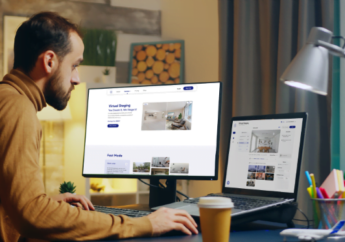What Type of Equipment is Needed to Accommodate Employees with Hearing Impairment?
by Mashum Mollah Technology Published on: 09 November 2020 Last Updated on: 16 November 2023

Any employer in the United States with 15 or more employees is subject to the Americans with Disabilities Act (ADA). The legislation became law in 1990 to help benefit disabled individuals, and it has proven significant for those who are deaf or suffering severe hearing loss. 1 in 5 Americans over the age of 12 experience some form of hearing impairment.
This means it’s likely that a company will either interview or hire someone with hearing loss at some point. No employer can ask a job candidate if they have a hearing loss under the Equal Employment Opportunity Commission (EEOC). However, an employer can ask questions related to a candidate’s ability to perform essential job functions in a noisy environment and the ability to meet safety standard mandates.
Employers are required to provide accommodations for employees with hearing loss, provided the adjustments aren’t too difficult or expensive. Adjustments could include having a sign language interpreter present at meetings, providing assistive listening devices such as captioned telephones, computer software, or strobe light emergency alerting systems.
Assistive Technology
The use of assistive technology is a great option for helping employees with hearing loss. Communicating on the phone can be challenging for those with hearing loss. For those with severe hearing loss, a handset amplification system, captioned phones, video phones for video relay service (VRS), and flashing indicator lights in place of phone notification sounds are all effective assistive technologies.

Wearing the best hearing aids for your level of hearing loss starts with a hearing test performed by an audiologist. Hearing aids have a range of special features and options that help you achieve better hearing based on your lifestyle. According to a recent industry study, the number of people that begin using rechargeable hearing aids is increasing by more than double every year. For example, Hearing Health USA is an audiologist company that specializes in different styles of hearing aids at affordable prices from the top hearing aid brands such as Widex, Starkey, and Signia.
A hearing specialist will determine the type and severity of your hearing loss and discuss the best hearing aid for your needs. There are several common types of hearing aids including:
- In-the-Ear (ITE) is best for severe hearing loss and can connect to cell phones and are compatible with remote controls.
- Completely-in-Canal (CIC) are discreet and have special features such as the ability to connect to cell phones and remote controls.
- Behind-the-Ear (BTE) sits on top of the outer ear and directs sound via a tube into the ear canal.
- Receiver-in-Canal (RIC) is a small device that carries sound into the ear canal via a tube and can connect to cell phones and remote controls.
Whether you need new hearing aids with Bluetooth or rechargeable batteries, or something suited for noisy environments or a quiet room, an audiologist can help you find the right hearing aid that can help you achieve better hearing and better quality of life.
Improved Work Environment

There are several logistical steps employers can take to create a better work environment for employees with hearing loss. For example, the company should have visual cues for emergencies, including blinking lights to direct where exits are and markers for emergencies. It’s important to reduce as much extra background noise as possible as hearing aid wearers experience them far more loudly than employees with normal hearing. Changes in workplace layout or desk arrangements can make a big difference in sound quality, which can make a huge difference for employees who are using hearing aids.
Workplace Communication
Before welcoming a new employee with hearing loss into the workplace, hold a department meeting to let existing employees know. Discuss the new adjustments to the workplace and the best practices for reducing loud noises, creating a better listening experience, and ensuring all communications are understood. Another adjustment is to communicate directly with employees with hearing loss through written memos and emails.

Staying on top of CPE requirements for an entire company takes a lot of time and resources. When employees are up-to-date on the latest industry changes, they can deliver more exceptional performance and higher operational efficiency. The best fit CPE solution features specific applications and customized training designed specifically for your company.
The CPE solutions from Wolters Kluwer are a good choice when you need a cost-effective way to see substantial increases in performance. Their broad portfolio of solutions helps you meet CPE requirements through live webinars, web-based self-study courses, and firm CPE subscriptions. Their solutions come with a money-back guarantee and convenient customer service options to ensure you discover the best fit CPE solutions for your employees.
As an employer, there are several adjustments you can make to accommodate employees with hearing loss. Using assistive technology, creating a better work environment, and updating workplace communication are some of the effective ways you can accommodate employees with severe hearing loss with ease.
Read Also:







































































































